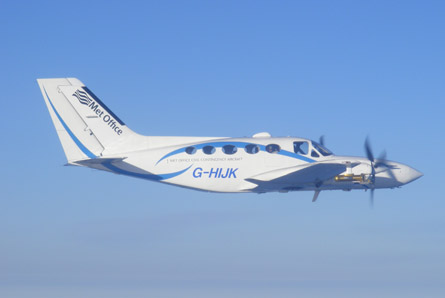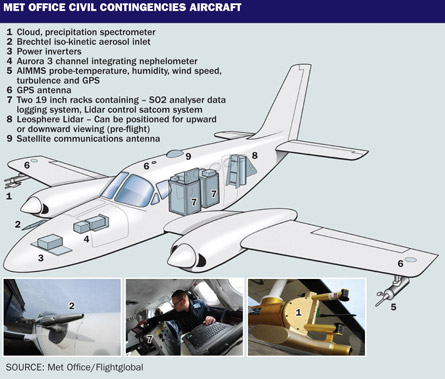A new ash-monitoring resource in the form of a specially equipped aircraft is about to go fully operational on behalf of the UK Civil Aviation Authority. The twin-engined Cessna 421C, known as the Met Office Civil Contingency Aircraft (MOCCA), is piston- rather than turbine-powered to give it greater resilience when it encounters ash.
It has been fitted with an array of sensors (see diagram below) that will enable it to "see" ash concentrations at different levels and take measurements of atmospheric contaminants for analysis.
 |
|---|
| © Cranfield Aerospace |
The idea for creating a purpose-built airborne platform such as this one for atmospheric research - with a heavy emphasis on ash - came from Cranfield Aerospace, working with special missions operator DO Systems based at Bournemouth in the UK.
OPERATIONAL CONTROL
David Gardner, Cranfield Aerospace managing director, says the company made an unsolicited approach to the UK's Met Office and the Civil Aviation Authority with their plan, and it was "well received". Although the aircraft is owned by Cranfield, the equipment has been specified by the Met Office, which has operational control of the MOCCA's deployment. The funding comes from the UK Civil Aviation Authority on the basis of its responsibility for assuring the safety of UK airspace.
The aircraft (now G-HIJK), built in 1977, is pressurised for high-altitude flight and is powered by two Teledyne Continental turbocharged engines. It is so packed with specialist equipment there is only room for a maximum crew of three. DO Systems says a typical mission crew would be one pilot and a Met Office scientific systems operator.
The main multi-purpose sensor, mounted externally under the starboard wingtip, is the cloud aerosol precipitation spectrometer (CAPS), which detects, measures, identifies and samples particles or droplets of all types in the atmosphere, and chemicals such as sulphur dioxide.
A Brechtel probe - looking like an oversized pitot tube - inducts air and particles into a chamber in the nose cone to record measurements such as mass and density.
Under the port wingtip is an AIMMS probe that measures the aircraft's position and altitude by differential GPS, pressure, temperature, humidity and atmospheric behaviour - for example, upper winds and turbulence. This meteorological data puts all the other measurements in context.

Satellite communications transmit data on ash and other atmospheric pollutants in frequent bursts to receivers on the ground managed by the London Volcanic Ash Advisory Centre at the Met Office's headquarters in Exeter, UK.
Jonathan Taylor, the Met Office's head of observation-based research, says the aircraft can contribute to multinational efforts to enable safe aviation operations when volcanic ash is affecting European airspace, but its primary responsibility is UK airspace.
It can also detect and monitor other atmospheric pollutants, hence the Cessna's generic description as a "civil contingencies" aircraft. Taylor cites the example of the Buncefield oil storage site explosion a few years ago. The aircraft's sensors can identify atmospheric pollution levels that result from such an event, the locations that will be affected, and the risks involved.
Source: Flight International























